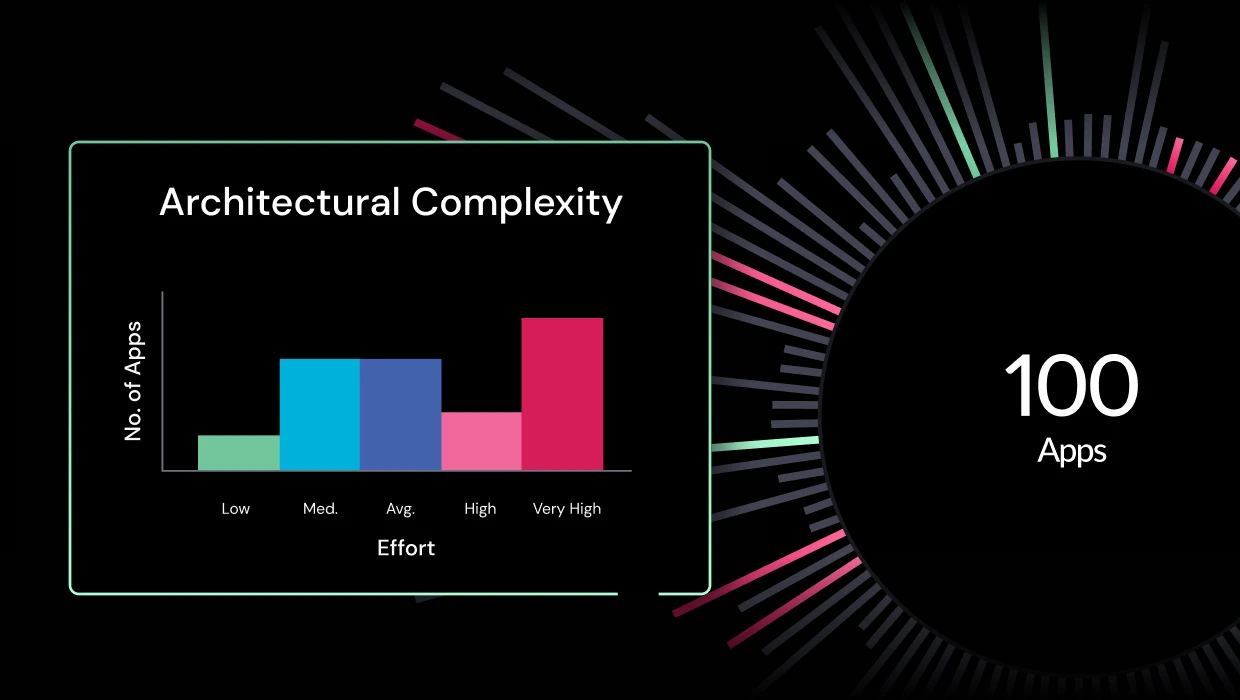The transition from a monolith to microservices has become popular in the digital world because of its multiple benefits, including business agility, flexibility, and elimination of barriers associated with monolithic applications. You can enjoy these benefits by refactoring a monolith application to microservices.
And here, we explore the benefits of refactoring a monolith to microservices and the best practices of doing so.
Refactoring a Monolith to Microservices: Understanding the terms
With more and more companies moving to a cloud-first architecture, it is essential to understand the difference between monolithic applications and microservices. The two are styles of program architecture.
An enterprise application has three parts: the database, a client application, and a server application. On the server application, there is a web interface, data layer, and business logic layer. This can be designed as a single monolithic block or as small independent pieces known as microservices.
A monolith application has all its components located in one program. It means that the web interface, data layer, and business logic layer are built in a single unit of application such as WAR or JAR. Most legacy applications are established as monoliths, and converting them to microservices is beneficial.
Related: Succeed with an Application Modernization Roadmap
Microservices architecture consists of small, autonomous programs that run independently and communicate via API (Application Programming Interface). One of the core benefits of microservices is that the individual components work differently and achieve their goals faster. The application can combine web analytics with e-commerce or AI services from different providers to work together and support different business procedures.
Benefits of Microservices in Detail
Microservices architecture has multiple other perks, including agility, scalability, upgradability, velocity, cost, and more. Let us discuss the advantages in detail.
Agility
The design of a microservice allows it to be disconnected from the rest of the system or program. As such, any adjustments made to it will not affect the functionality of the system.
As a developer, you need not worry about complex integrations, which means making changes is easier, and there’s no need for a long testing time. So, migrating monolithic applications to microservice architecture is most often the best option as it enhances agility.
Great Focus on Value and Capabilities
Microservices users are not required to understand how it functions, the programming language it employs, or its internal logic. They just need to learn how to access and call its API method and know the data it returns. In essence, microservices can be reused across applications when they are well-designed.
Flexibility
Microservices architecture is self-contained. Designers are free to use frameworks, programming languages, databases, and other tools of their choice. If they wish, users can update to newer versions or switch between different languages or tools. As long as the exposed APIs aren’t modified, no one else is affected.
Automation
When comparing monolithic to microservices apps, the importance of automation cannot be understated. Microservices design allows for the automation of various essential operations that would otherwise be manual and tedious, such as building, integration, testing, and continuous deployment. As a result, employee productivity and satisfaction increase.
Cost-Effective
A nicely designed microservice is small enough to be developed, tested, and released by a single team. With the codebase being smaller, understanding it is easier, which maximizes team productivity. Additionally, since the business logic and data storage isn’t used to connect microservices, dependencies are reduced to a minimum. All of this contributes to improved team communication and lower management costs.
Easy Upgrading
One of the most significant differences between monolithic apps and microservices is upgradability. It’s crucial in today’s fast-paced market. Since it is possible to deploy a microservice independently, it’s easier to repair errors and add new features.
A single service can be deployed without having to reinstall the entire program. It is possible to roll back the erring service if problems are discovered during deployment. This is more convenient than deleting the entire application.
Increased Velocity
All of the advantages above lead to teams concentrating on rapidly producing and delivering value, resulting in a velocity increase. Organizations can therefore adapt quickly to shifting business and technological demands.
Related: Advantages of Microservices in Java
Why Refactoring A Monolith To Microservices Is The Best Migration Approach
In recent years, the popularity of cloud applications has led to a critical question: Which is the best approach to ensure long-term success? Refactoring has historically been rated as the most intensive migration approach, but new automated tools are changing that calculus. It is a disciplined process where developers review, rearchitect and re-code components of applications before migrating to the cloud.
This approach is adopted to fully take advantage of native cloud features and the flexibility they offer. Despite the resource commitment and the upfront cost, refactoring serves as the ideal way of producing the best return on investment in the long run. In addition, it offers a continuous cloud innovation model, with improvements in operations, functionality, resilience, security, and responsiveness.
While refactoring a monolith to microservices, instead of the traditional time-consuming manual approach, we advocate that you use modern automation tools and also avoid refactoring all of your code at once while modernizing your application. Instead, we recommend refactoring the monolithic program in stages.
Why Not Just Use The Lift-And-Shift Approach To Get To Cloud?
Over the last decade, cloud experts and analysts have developed a conventional wisdom that it is desirable to move applications to cloud computing infrastructure. Besides, this is very handy in the modernization effort.
Think of successful companies like Uber and Netflix, which were established in the cloud. Emulating them will lead to fast-growing and more productive companies. Moving to the cloud means re-platforming applications. This involves lifting databases and VMs from conventional servers to pay-as-you-go models with an IaaS provider.
The lift-and-shift approach is also in the cloud, and it provides excellent capabilities like maintenance of parallel instances or reserving excess capacity for recovery or failover purposes. However, because of the hefty nature of monolith applications, you might rack up shockingly large storage and compute costs while still having difficulty adding new functionality.
This approach is not able to achieve efficient scaling or modern cloud-native agility. Therefore, refactoring a monolith to microservices remains the best method for a company aiming at achieving long-term success.
Migrating Monolithic Apps to Microservices: Best Practices
When refactoring a monolith to microservices, you can do it manually or automatically. Below are guidelines to help you modernize your app, whether you go the manual way or use automated tools.
Find a Decoupled, Basic Functionality
Begin with functionality already separated from the monolith which doesn’t need changes to client-facing apps or the use of a data store. This should be converted into a microservice. It assists the team in upskilling and establishing the minimalistic DevOps architecture required in building and deploying the microservice.
Eliminate the Microservices Dependency on Monoliths
The dependence of freshly formed microservices on monoliths should be decreased or eliminated. New dependencies between the monolith and the microservices are established during the decomposition process. This is great because it does not affect the speed with which new microservices are built. The most challenging element of refactoring is generally identifying and eliminating dependencies.
We also recommend extracting modules with requirements that differ from the rest of the monolith. For instance, a module containing an in-memory database can be converted into a service and deployed on servers with better memory. Making the application considerably easier to scale by turning modules with specific resource requirements into services is possible.
Check out and Split the Sticky Functionality
Identify any form of sticky functionality in the monolith that too many monolith functions rely on unnecessarily. This will make removing additional independent microservices from the monolithic app difficult. To move ahead, flip the script on lift-and-shift modernization with refactoring. It can be a time-consuming and frustrating task, but the results are satisfying.
Use Vertical Decoupling
Usually, many decoupling attempts begin by separating user-facing functions to permit independent UI updates. Because of this technique, monolithic data storage becomes a velocity limiting issue.
Instead, the functionality should be split into vertical “pieces,” with each piece containing business logic, UI, and data storage capabilities. The most difficult thing to unravel is knowing what business logic is dependent on which database tables. You must carefully separate the logic, capability data, and user-facing elements and direct them directly to the new service to successfully decouple capabilities from a monolithic app.
Prioritize Decoupling the Most Used and Changed Functionality
The main purpose of migrating microservices to the cloud is to speed up updates to monolithic features. To do so, the developers must first determine the most often modified functionality. The quickest and most cost-effective solution is to move this functionality to microservices. Focus on refactoring the business domain with the best business value.
Start with Macro, then go Micro
The new microservices should not be too small, at least at first, since this generates a complex and difficult-to-debug system. The recommended strategy is to start with fewer services, each with more capability, and then break them up afterward.
Use Evolutionary Steps to Migrate
Refactoring a monolith to microservices should be done in small, atomic stages. The atomic steps involve the creation of new services, routing of clients to the new services. It also involves retiring the code within the monolith that was previously delivering this functionality. This ensures that the developing team gets closer to the ideal design with each atomic step.
Note that the migrating app should work with all monolithic applications. The scale, agility, velocity upgradability, and affordability are some of the advantages the process should provide. These factors should not be negatively impacted at any point, and the migration should be completed quickly, intelligently, and automatically.
Simplifying the Migration Process
When examining refactoring a monolith to microservices, it’s evident that manual transformation is time-consuming, error-prone, labor-intensive, and requires significant architecture knowledge. These skills are lacking in the majority of companies.
How about migrating automatically? Would it not be great if you could just drop a monolith application into a software modernization platform? This would have all of the time-consuming and complicated stages above accelerated and simplified. All the above best practices should be followed but in an intelligent, automated, and repeatable way.
Is there an Ideal Platform for Refactoring a Monolith to Microservices?
Refactoring an operational app into microservices has multiple benefits, as explored above. However, refactoring a monolithic to microservice isn’t a walk in the park. The developers must look for the best platform that can help in performing the task smoothly.
Are you wondering whether there is an ideal platform for this migration? Many platforms exist in the market, and you may get confused about the best product to use. If you’re in this situation, vFunction can help. It’s the first and only platform that allows developers to effectively and automatically refactor a monolith to microservices. It also restores the engineering velocity and optimizes the benefits of the cloud.
Some of the benefits include the elimination of cost constraints, risks, and time associated with manually modernizing your applications. Headquartered in Palo Alto, CA, with offices in Israel, vFunction is led by a team experienced who have been in the IT industry for a long time.
Do you want to learn more about vFunction? If yes, please request a demo to explore how vFunction helps your application become a modern and truly cloud-native application while improving its performance, scalability.






